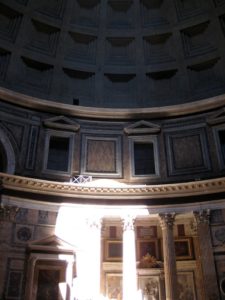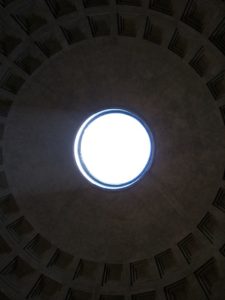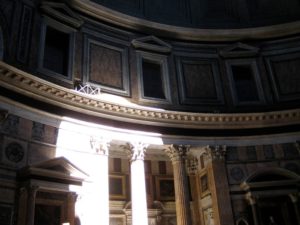Over the last couple of week’s I’ve taken the chance to catch up on my reading and one I read was about architecture (I likes it), I was thinking of those places that really made me stand and think. Yes it’s the beginning of another list of places that have really moved me at some time. I think lists can be fun.
I think my first stop would be on many peoples lists. It’s been a church for a number deities for almost two thousand years. The engineering (yes it comes back to the engineering) was so advanced, the understanding of weight distribution was so far beyond what the rest of the work knew that it would be 1500 years before anything as impressive was built in Europe.
For anyone who has not yet experienced the Pantheon no depiction of it will ever come close to doing it the justice. That is my disclosure. Alas, for a second best alternative, here are my reflections on the Pantheon in Rome.
We arrived in the Piazza della Rotonda slightly jetlagged on a beautiful autumn morning in Rome. The sun was already bright and the Piazza barely showing signs of activity, the crows of tourists were an hour or two away yet. A former traveling companion used to all this “Swiss sightseeing”, I prefer to think of it as “Jetlagged sightseeing” and being up this early is rarely voluntary.
 In the piazza is a tall fountain topped by an obelisk standing tall above the fountain. To think that two millennia ago the romans marched to Egypt, with the authority possessed only by victors and took what they liked home.
In the piazza is a tall fountain topped by an obelisk standing tall above the fountain. To think that two millennia ago the romans marched to Egypt, with the authority possessed only by victors and took what they liked home.
The obelisk was ancient to the romans, and dates from some where around 1250BC. Today it is hard to understand an empire that reached it height two thousand years ago saw items as antiquities to be shared at home. The British, French, Germans and Dutch all did the same thing; filling their museums with wonders from around the parts of the world they considered theirs.
The Piazza della Rotonda is no different in this respect from dozens of other busy plazas across this quite wonderful city.
The fountain is nothing but a side show, for as you turn around to face the Pantheon and look at the eight symmetrical columns that mark the entrance. The detail in the stone work is astounding, they support a huge façade that reads “M·AGRIPPA·L·F·COS·TERTIVM·FECIT“, this translates to “‘Marcus Agrippa, son of Lucius, Consul for the third time, built this.” The original church was rebuilt twice, so we see the third building on this site.
The original was built by Marcus Agrippa in 27BC, this was destroyed by fire a little over 100 years later and was rebuilt by in 82AD. That building lasted less then thirty years before it too was consumed by fire again. The third building, the one that we see today was commissioned by Hadrian and finished in 126AD.
 As you pass under the facade, through the columns you enter the church through giant bronze doors. Your immediate instinct as you step in is to look up at the roof, not just to see the stark contrast of the blue sky through the oculus, but to take in the shear scale of the building. The imagery offered by the oculus is clear, even to a heathen such as I. It symbolizes the entrance to heaven, the place where those who offered their faith here over the centuries believed they were going.
As you pass under the facade, through the columns you enter the church through giant bronze doors. Your immediate instinct as you step in is to look up at the roof, not just to see the stark contrast of the blue sky through the oculus, but to take in the shear scale of the building. The imagery offered by the oculus is clear, even to a heathen such as I. It symbolizes the entrance to heaven, the place where those who offered their faith here over the centuries believed they were going.
The rotunda itself is largely open, there are a few rows of pews facing the alter on the far wall as you walk in, but otherwise it is left open. The building is a working church and still holds regular catholic services. The interior walls are incredibly detailed; there is something in every corner of the rotunda. Some dates from the 1600, some goes back to the original builders.
When built the Pantheon was dedicated to all the Pagan gods of the Roman Empire. It became the first Roman temple to be converted to Christianity and that’s why it’s been so well preserved over the centuries. Personally I really don’t mind which church it represents, my thoughts on religion are clear and well documented.
 So with my ME hat on it’s clear that well over two thousand years ago the Roman Empire understood science, engineering, architecture. Not only did they know this, but understood it in a way that would not be rediscovered for an agonizingly long time, maybe until the great cathedrals were built in the 14 and 1500’s.
So with my ME hat on it’s clear that well over two thousand years ago the Roman Empire understood science, engineering, architecture. Not only did they know this, but understood it in a way that would not be rediscovered for an agonizingly long time, maybe until the great cathedrals were built in the 14 and 1500’s.
I’d argue that even today we don’t see the depth to which the Romans understood and applied the beauty of engineering and architecture to their world. Rome is a city best seen on foot, it’s got so much to see, but is built somehow on a human scale. The Romans left behind indelible marks that today, two-thousand years later are still something to admire and behold.

2 Comments
Wonderful Roma is the perfect city to spend time on, nowhere is like it.
Dave, you are lucky to see the eternal city in the fall. It’s the best time. the walk from St Peters to the Colosseum is long, but has so much history. I wait eagerly for more